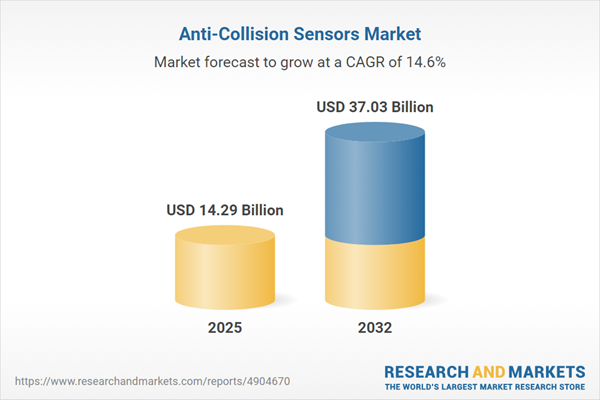Speak directly to the analyst to clarify any post sales queries you may have.
Anti-collision sensors are reshaping risk management, automation, and operational continuity for modern enterprises. As digital transformation accelerates, senior leaders are prioritizing these solutions to enhance safety, reliability, and competitive positioning across dynamic business environments.
Market Snapshot: Anti-Collision Sensors Market Overview
The global anti-collision sensors market is valued at USD 12.49 billion in 2024 and is projected to reach USD 37.03 billion by 2032, representing a compound annual growth rate (CAGR) of 14.55%. Market expansion is propelled by the wide adoption of advanced sensor technologies across verticals such as automotive, aerospace, robotics, healthcare, and industrial automation. Enterprises are advancing safety protocols, investing in asset protection, and integrating digital systems at scale. This increasing reliance on anti-collision sensors highlights their pivotal role in supporting business continuity, compliance, and alignment with fast-evolving industry standards.
Scope & Segmentation of the Anti-Collision Sensors Market
This report provides targeted market intelligence to guide executive decision-making, highlighting crucial segment details and trends relevant to corporate strategy.
- Vehicle Types: Focuses on commercial and passenger vehicles, with insights into how industry regulations and diverse urban infrastructures are shaping deployment strategies and fleet modernization approaches.
- Sensor Types: Covers infrared, LiDAR, radar, and ultrasonic sensors, detailing the unique operational benefits of each. Infrared and ultrasonic options enhance proximity detection, while LiDAR and radar deliver precise object and terrain mapping for high-mobility environments.
- Applications: Analyzes anti-collision sensor roles in automotive manufacturing, industrial automation, robotics, defense, and healthcare. Applications emphasize asset protection, personnel safeguarding, and optimization of process flows as companies scale operations.
- Regional Coverage: Considers the Americas, EMEA, and Asia-Pacific, addressing local adaptation drivers including regulatory compliance, supply chain challenges, and logistics infrastructure. Regional market trends and policy frameworks are examined to illuminate strategic opportunities.
- Key Companies: Profiles industry leaders such as Robert Bosch GmbH, Continental AG, Denso Corporation, Valeo S.A., ZF Friedrichshafen AG, Aptiv plc, Autoliv Inc., Infineon Technologies AG, NXP Semiconductors N.V., and Texas Instruments Incorporated, outlining their innovation strategies and influence on sector development.
Key Takeaways for Senior Decision-Makers
- Implementing robust sensor architectures accelerates automation and supports connectivity across corporate operations, positioning organizations to meet shifting safety and reliability requirements.
- Strict regulatory climates are prompting industries to fortify risk controls and integrate advanced detection systems, especially in environments with heightened safety or oversight needs.
- Emergent integrations of artificial intelligence and edge computing into sensor platforms enable faster system responses, enhancing protection in mission-critical use cases and supporting rapid intervention.
- Customizable anti-collision solutions provide executives with increased real-time visibility and control over intricate fleet and logistics processes.
- Regional adoption strategies differ: Asia-Pacific markets pursue broad automation initiatives, EMEA prioritizes compliance complexities, and the Americas continue to trial innovative sensor applications in structured scenarios.
- A balanced approach blending hardware and software allows organizations to respond flexibly to technological shifts and evolving autonomous operational landscapes.
Tariff Impact: Navigating Supply Chain and Cost Structure Shifts
Recent changes in U.S. tariff regimes are reshaping sourcing and production decisions for anti-collision sensors. Enterprises are prioritizing proximity-based manufacturing and supply chain efficiency enhancements to maintain technology access and stable deliveries amid global trade uncertainties. These adaptations strengthen supply chain resilience and ensure alignment with evolving international regulatory frameworks covering anti-collision device production and distribution.
Methodology & Data Sources
This market analysis leverages executive interviews from OEM and logistics stakeholders, in-depth industry research, patent landscape reviews, and analysis of international trade data. Scenario assessments and expert validation panels provide additional rigor, ensuring insights support credible, actionable leadership decisions.
Why This Report Matters
- Equips executives with context to anticipate shifts in regulation, technology, and operations for anti-collision detection systems.
- Identifies actionable opportunities tailored to regions and segments, strengthening procurement, investment, and risk management strategies.
- Supports decision-makers as they address complexities in compliance, supply chains, and emergent anti-collision technologies.
Conclusion
This report empowers senior leaders to strengthen organizational safety strategies and adapt to changes in industrial risk management through strategic deployment of anti-collision sensor technologies.
Additional Product Information:
- Purchase of this report includes 1 year online access with quarterly updates.
- This report can be updated on request. Please contact our Customer Experience team using the Ask a Question widget on our website.
Table of Contents
3. Executive Summary
4. Market Overview
7. Cumulative Impact of Artificial Intelligence 2025
Companies Mentioned
The companies profiled in this Anti-Collision Sensors market report include:- Robert Bosch GmbH
- Continental AG
- Denso Corporation
- Valeo S.A.
- ZF Friedrichshafen AG
- Aptiv plc
- Autoliv, Inc.
- Infineon Technologies AG
- NXP Semiconductors N.V.
- Texas Instruments Incorporated
Table Information
| Report Attribute | Details |
|---|---|
| No. of Pages | 193 |
| Published | October 2025 |
| Forecast Period | 2025 - 2032 |
| Estimated Market Value ( USD | $ 14.29 Billion |
| Forecasted Market Value ( USD | $ 37.03 Billion |
| Compound Annual Growth Rate | 14.5% |
| Regions Covered | Global |
| No. of Companies Mentioned | 11 |









